1、 LCD驱动学习

在 Linux 中应用程序最终也是通过操作 RGB LCD 的显存来实现在 LCD 上显示字符、图片等信息。在裸机中我们可以随意的分配显存,但是在 Linux 系统中内存的管理很严格, 显存是需要申请的,不是你想用就能用的 。而且因为虚拟内存的存在,驱动程序设置的显存和应用程序访问的显存要是同一片物理内存。为了解决上述问题,Framebuffer 诞生了, Framebuffer 翻译过来就是帧缓冲
fb 是一种机制,将系统中所有跟显示有关的硬件以及软件集合起来,虚拟出一个 fb 设备 ,当我们编写好 LCD 驱动以后会生成一个名为 /dev/fbX(X=0~n) 的设备,应用程序通过访问/dev/fbX 这个设备就可以访问 LCD。
LCD又分LCD控制器和具体屏幕参数,前者由厂家写好了,所以实际应用时我们只需要改后者
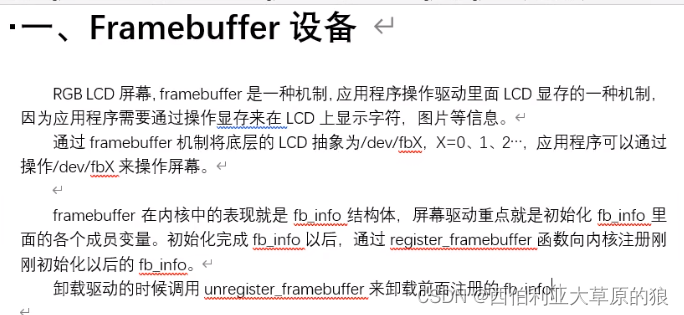
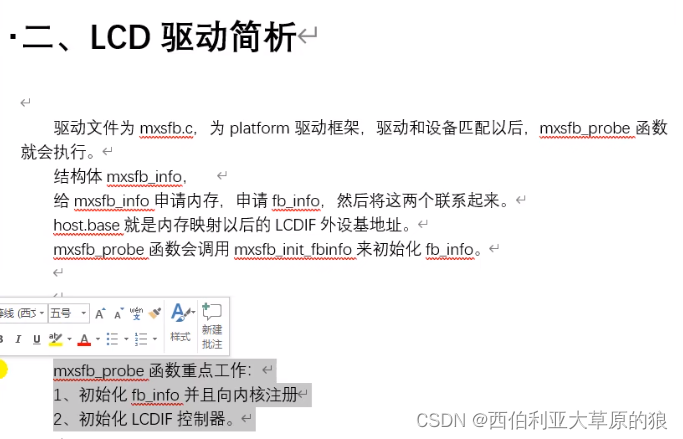
&lcdif {
pinctrl-names = "default";
pinctrl-0 = <&pinctrl_lcdif_dat
&pinctrl_lcdif_ctrl>;
display = <&display0>;
status = "okay";
/* 7寸1024*600 */
display0: display {
bits-per-pixel = <24>;
bus-width = <24>;
display-timings {
native-mode = <&timing0>;
timing0: timing0 {
clock-frequency = <51200000>;
hactive = <1024>;
vactive = <600>;
hfront-porch = <160>;
hback-porch = <140>;
hsync-len = <20>;
vback-porch = <20>;
vfront-porch = <12>;
vsync-len = <3>;
hsync-active = <0>;
vsync-active = <0>;
de-active = <1>;
pixelclk-active = <0>;
};
};
};
/* 4.3寸480*272 */
/* display0: display {
bits-per-pixel = <24>;
bus-width = <24>;
display-timings {
native-mode = <&timing0>;
timing0: timing0 {
clock-frequency = <9000000>;
hactive = <480>;
vactive = <272>;
hfront-porch = <5>;
hback-porch = <40>;
hsync-len = <1>;
vback-porch = <8>;
vfront-porch = <8>;
vsync-len = <1>;
hsync-active = <0>;
vsync-active = <0>;
de-active = <1>;
pixelclk-active = <0>;
};
};
};*/
/* 4.3寸800*480 */
/* display0: display {
bits-per-pixel = <24>;
bus-width = <24>;
display-timings {
native-mode = <&timing0>;
timing0: timing0 {
clock-frequency = <31000000>;
hactive = <800>;
vactive = <480>;
hfront-porch = <40>;
hback-porch = <88>;
hsync-len = <48>;
vback-porch = <32>;
vfront-porch = <13>;
vsync-len = <3>;
hsync-active = <0>;
vsync-active = <0>;
de-active = <1>;
pixelclk-active = <0>;
};
};
};*/
};
backlight {
compatible = "pwm-backlight";
pwms = <&pwm1 0 5000000>;
brightness-levels = <0 4 8 16 32 64 128 255>;
default-brightness-level = <7>;
status = "okay";
};=========================================================================
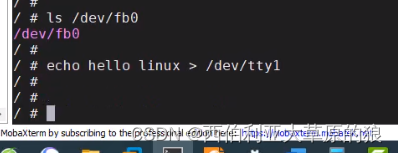
将屏幕设置为终端 (要注意,方便后期改回来)
此时有两个终端,各干各的 并不同步
只删console=tty1,剩下的不用
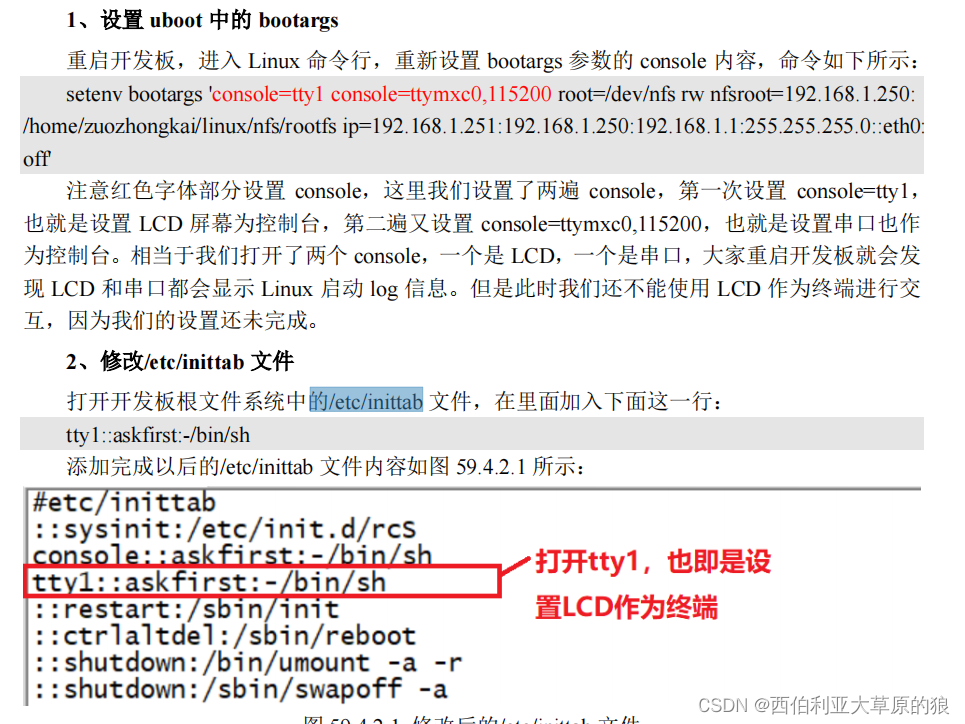
2、RTC驱动学习(字符设备驱动)
RTC 也就是实时时钟,用于记录当前系统时间,对于 Linux 系统而言时间是非常重要的, 就和我们使用 Windows 电脑或手机查看时间一样,我们在使用 Linux 设备的时候也需要查看时间。
Linux 内核将 RTC 设备抽象为 rtc_device 结构体 ,因此 RTC 设备驱动就是申请并初始化rtc_device,最后将 rtc_device 注册到 Linux 内核里面,这样 Linux 内核就有一个 RTC 设备的。 至于 RTC 设备的操作肯定是用一个操作集合 ( 结构体 ) 来表示的,我们先来看一下 rtc_device 结构体,此结构体定义在 include/linux/rtc.h 文件中
我们需要重点关注的是 ops 成员变量 ,这是一个 rtc_class_ops 类型的指针变量, rtc_class_ops 为 RTC 设备的最底层操作函数集合,包括从 RTC 设备中读取时间、向 RTC 设备写入新的时间 值等。因此,rtc_class_ops 是需要用户根据所使用的 RTC 设备编写的,此结构体定义在 include/linux/rtc.h 文件中,内容如下: (读时间,设置时间,读定时,设置定时)
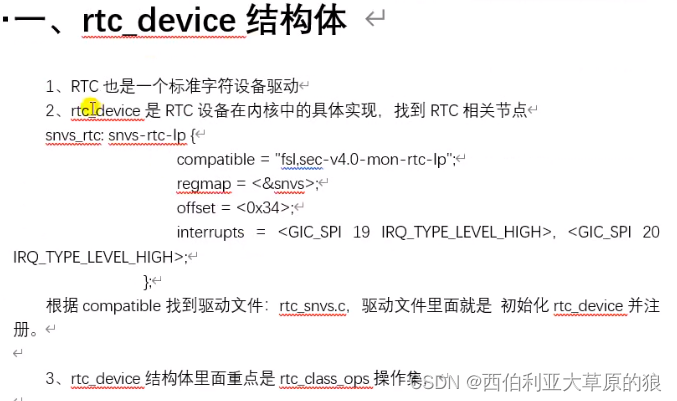
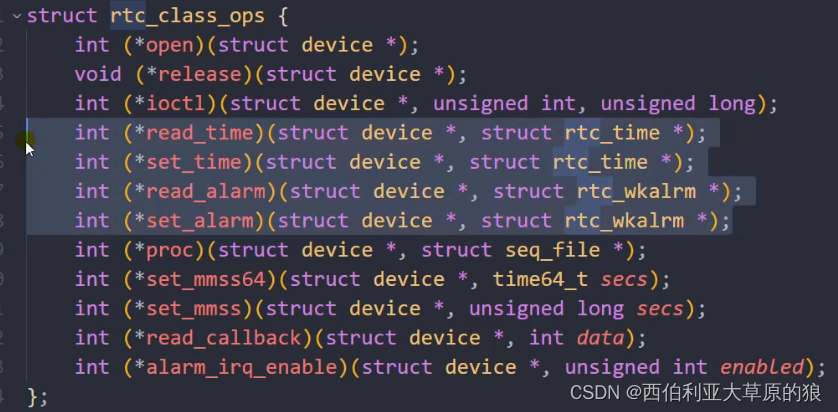
看名字就知道 rtc_class_ops 操作集合中的这些函数是做什么的了,但是我们要注意,
rtc_class_ops 中的这些函数只是最底层的 RTC 设备操作函数,并不是提供给应用层的 file_operations 函数操作集。 RTC 是个字符设备,那么肯定有字符设备的 file_operations 函数操 作集,Linux 内核提供了一个 RTC 通用字符设备驱动文件,文件名为 drivers/rtc/rtc-dev.c , rtc
dev.c 文件提供了所有 RTC 设备共用的 file_operations 函数操作集,
当 rtc_class_ops 准备好以后需要将其 注册 到 Linux 内核中,这里我们可以使用 rtc_device_registe r函数完成注册工作。此函数会申请一个 rtc_device 并且初始化这个 rtc_device ,最后向调用者返回这个 rtc_device
当 卸载 RTC 驱动的时候需要调用 rtc_device_unregister 函数来注销注册的 rtc_device ,函数原型如下:

arm-linux-gnueabihf-gcc zhang.c -o zhang
sudo cp zhang /home/whz/linux/nfs/rootfs/lib/modules/4.1.15/ -f
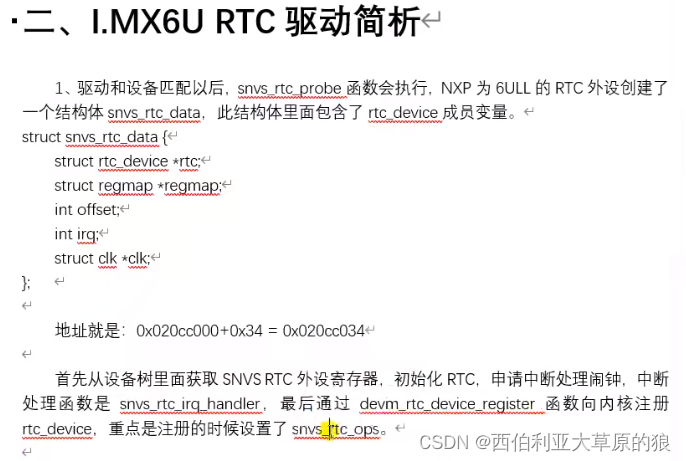

date //查看时间
date -s "2022-09-05 19:54:00" //设置时间
本文含有隐藏内容,请 开通VIP 后查看